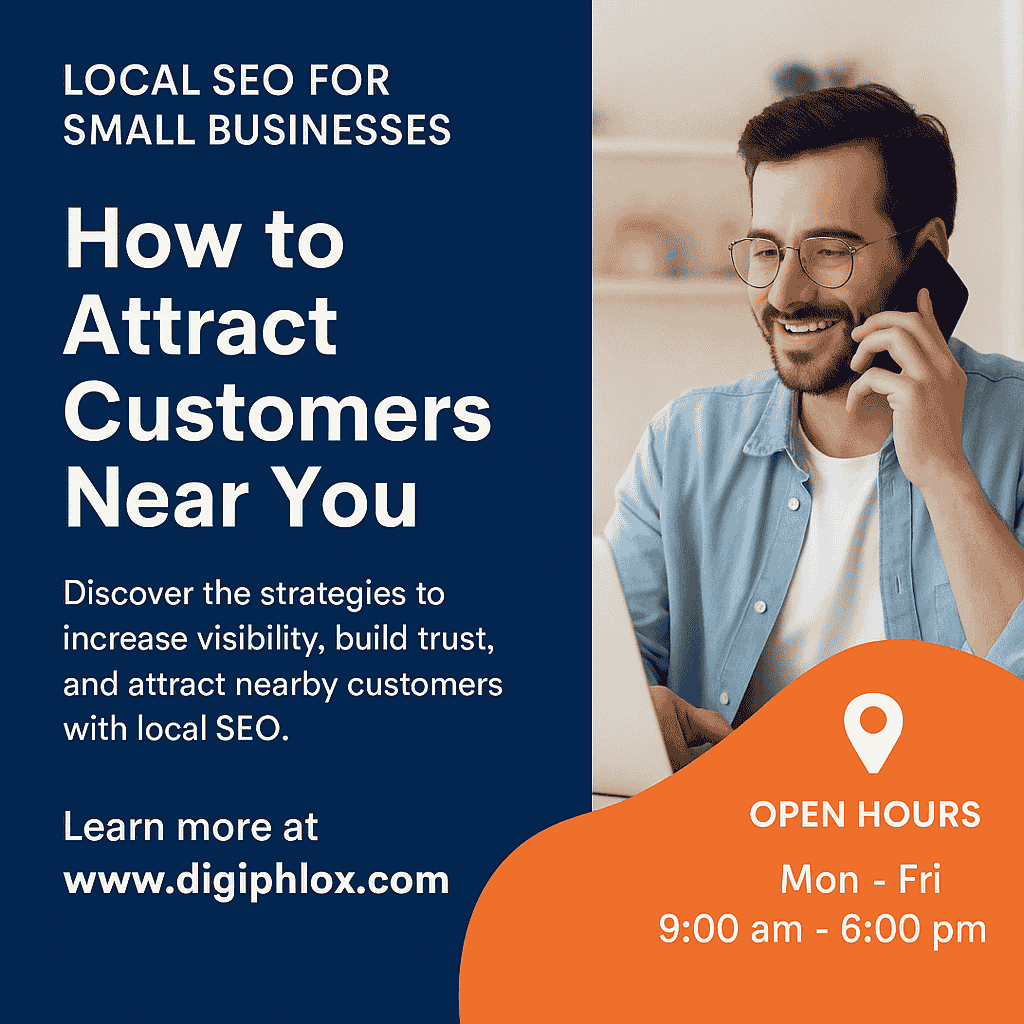Introduction
In today’s competitive digital landscape, local SEO for small business has become one of the most effective ways to reach nearby customers. People no longer rely only on word of mouth; instead, they search on Google using terms like “best salon near me” or “restaurant in Ramnagar.” For a small business, this presents a golden opportunity. Focusing on Local SEO allows you to improve visibility, build reliability, and reach more customers around you.
In this blog, we’ll explain what Local SEO is, why it’s important, and the exact strategies that make it work. And remember: Creating a Google Business Profile is not enough—it also needs to rank well on Google. For that, you can rely on Digiphlox.

What is Local SEO for Small Business?
Local SEO for small business means enhancing your digital presence so that potential customers in your area can easily find you in search results. Where global SEO targets audiences worldwide, Local SEO focuses on local queries like ‘café in Nainital’ or ‘plumber near me.”
For small businesses, Local SEO creates equal opportunities in the market. Even if you don’t have a huge advertising budget, you can compete with larger companies by showing up in local search results when it matters most.
Why Local SEO Matters for Small Business
- High Intent Customers
Users looking for businesses nearby are typically ready to purchase. Someone typing “digital marketing agency near me” is actively looking for services.
- Boosted Visibility
Local SEO helps your business appear on Google Maps and in the “local pack” (the top 3 results with a map).
- Trust Factor
A business with strong local presence, reviews, and accurate information instantly appears more trustworthy.
- Mobile-Driven Searches
Most local searches happen on mobile. Optimizing for local SEO for small business ensures you capture this audience.
- Better ROI than Traditional Ads
Flyers, banners, or local newspapers are costly and short-lived. Local SEO, on the other hand, is cost-effective and delivers long-term results by keeping you visible to potential customers every day.
Proven Strategies in Local SEO for Small Business
1. Optimize Your Google Business Profile
A complete and optimized Google Business Profile (GBP) is the backbone of Local SEO. Add accurate business details, categories, photos, and updates.
But remember: Creating a Google Business Profile is not enough—it also needs to rank well on Google. For that, you can rely on Digiphlox.
2. Ensure NAP Consistency
NAP = Name, Address, Phone number. Make sure these details are exactly the same across your website, social media, and directories. Inconsistencies hurt your ranking and confuse search engines.
3. Collect and Manage Reviews
Reviews influence both search ranking and customer decisions. Encourage happy clients to leave Google reviews and always respond professionally.
Pro Tip: Offer small incentives like discounts or loyalty points to motivate customers to review your services. This not only improves your SEO but also builds a loyal customer base.
4. Optimize Your Website with Local Keywords
Your website represents the online identity of your small business. Use location-based keywords and highlight your services clearly.
Examples:
- “Best café in Ramnagar”
- “SEO services for small businesses in Uttarakhand”
- “Top salon near Corbett”
By weaving local SEO for small business into your content naturally, you’ll attract the right audience at the right time.
5. Mobile-Friendly Website
Small businesses benefit greatly from a fast, mobile-friendly site. Since most local searches are done on smartphones, your site must load fast and be easy to navigate. Include click-to-call buttons and location maps so users can reach you quickly.
6. Build Local Citations
Citations (mentions of your NAP on directories) are a strong ranking factor. Add your business to trusted sites like Justdial, IndiaMart, and local directories. Each citation increases your credibility in Google’s eyes.
7. Social Media Engagement
Social platforms help boost local reach. Share updates, promotions, and local news. Use hashtags like #RamnagarBusiness or #LocalSEOforSmallBusiness to attract nearby audiences.
Also, tag your location in posts and encourage customers to check in at your business—this creates valuable user-generated content that boosts visibility.
8. Location-Specific Pages
If your small business serves multiple areas, create unique location pages on your website. Each page should target a specific city or region with relevant keywords. This ensures that whether someone searches “café in Haldwani” or “salon in Ramnagar,” your business appears as a strong contender.
Common Mistakes Small Businesses Make in Local SEO
- Incomplete Google Business Profile.
- Wrong categories or missing photos.
- Ignoring reviews or negative feedback.
- Inconsistent NAP across platforms.
- Not using keywords for local SEO for small business.
- Forgetting mobile optimization, which costs valuable leads.
How Digiphlox Helps Small Businesses with Local SEO
At Digiphlox, we understand the unique challenges small businesses face. Our team specializes in local SEO for small business, ensuring that your Google Business Profile ranks, your website is optimized for local searches, and your brand gains visibility in your area.
We focus on:
- Optimizing GBP for higher rankings.
- Managing and improving reviews.
- Building strong local backlinks and citations.
- Creating location-based content strategies.
With Digiphlox, your small business doesn’t just appear online—it stands out and attracts the right customers.
Conclusion
For small businesses, local SEO is not just an option—it’s a necessity. By optimizing your Google Business Profile, managing reviews, ensuring NAP consistency, and targeting the right keywords, you can attract customers near you and grow your brand locally.
And don’t forget: Creating a Google Business Profile is not enough—it also needs to rank well on Google. For that, you can rely on Digiphlox.
With local SEO for small business, you’ll have a competitive edge, increased visibility, and a steady flow of nearby customers walking into your store or contacting you online.











